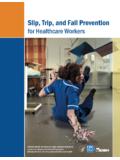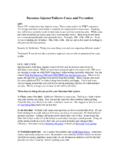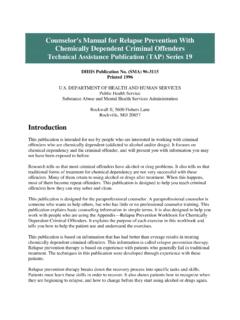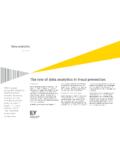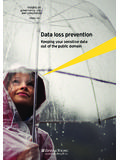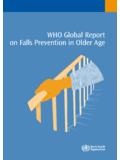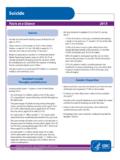Transcription of American Nurses Association’s Needlestick …
1 American Nurses association sNeedlestick prevention GuideAmerican Nurses association sNeedlestick prevention GuideSupported by an unrestricted educational grant from B-D, Inc. (Becton-Dickinson). 2002 American Nurses association . All rights reserved. TDICT forms reprinted with 1 Chapter One: The Information You 3 One nurse s Story .. 3 Work-Related Bloodborne Pathogen Exposure: The Risks for Health Care Workers .. 4 HIV/AIDS .. 6 Hepatitis C .. 8 Hepatitis B .. 9 Procedure to Follow After a Needlestick or Sharps Injury .. 10 prevention .. 12 Rights and Protections: OSHA Bloodborne Pathogens Standard .. 14 Chapter Two: Taking 16 Needlestick prevention Committee .. 16 Identify and Document Needlestick and Sharps Hazards .. 18 Using Contract Language .. 22 Filing an OSHA Complaint .. 23 Chapter Three: Device Evaluation, Selection,and 25 Step One: Broad Identification of All Market-Available Devices .. 26 Step Two: Three-Step Selection Process .. 28 Step Three: Institutionalizing Selected Devices.
2 30 Step Four: Ongoing Surveillance for Efficacy and for Better Devices .. 32 Appendix A: 33 Appendix B: OSHA Model Exposure Control 35 Appendix C: EPINet Sharps Reporting 47 Appendix D: TDICT Safety Feature Evaluation 50 Appendix E: TDICT Scenarios and Simulation 54 Table of Contents1 Every year, hundreds of thousands of health care workers are exposed to deadlydiseases like HIV and hepatitis C through Needlestick and sharps today s technology, Nurses no longer need to face such high risks. TheAmerican Nurses association (ANA) is dedicated to working with Nurses across thecountry to significantly reduce Needlestick and sharps injuries. Nurses should nothave to risk their lives every time they use a needle or sharps , as part of its ongoing Safe Needles Save Lives campaign, has created thisguide to help educate you and your colleagues about the risks of Needlestick injuriesand how to prevent them particularly through the evaluation, selection, and imple-mentation of safe needle and sharps devices.
3 Chapter One details the exposure risksfrom injuries especially from HIV, hepatitis C virus (HCV), and hepatitis B virus(HBV) and how these injuries can be prevented. It also outlines what steps youshould take after an injury and your legal rights and protections especially underthe federal 2000 Needlestick Safety and prevention Act. Chapters Two and Threefocus on how you and your colleagues cantake specific steps toward Needlestick pre-vention in your health care steps include creating a needlestickprevention committee, identifying and doc-umenting injuries, evaluating, selecting,and implementing safe devices, filing acomplaint with the Occupational Safetyand Health Administration (OSHA), andusing contract language. In 1999, ANA and the Training for the Development of Innovative ControlTechnologies Project (TDICT) partnered to develop training based on the TDICT process for the evaluation, selection, and implementation of safe devices. ChapterThree outlines that process, developed from dozens of workshops held across thecountry and from material created during 10 years of research by TDICT, using theexpertise of frontline health care workers, especially book is dedicated to the hundreds of health care workers across the countrywho have fought for Needlestick prevention especially to those Nurses who them-selves have been infected with serious diseases from Needlestick and sharps injuriesand to those who died from those diseases.
4 ANA also owes a special thanks to LyndaArnold, who started the inspirational, pioneering National Campaign for Health CareWorker Safety after she became infected with HIV from a Needlestick , we will continue the battle to protect health care workers, so that nursescan take care of patients without risking their own should not have torisk their lives every timethey use a needle orsharps nurse S STORYThe Unthinkable HappensIn 1997, Lisa Black, a 26-year-old nurse and single mom with two young daugh-ters, was excited about her career. She had always wanted to be a nurse . Onenight, she was caring for a patient in the terminal stages of AIDS. She noticedthat his intravenous (IV) tube was backed up with blood and the line was quickly irrigate the line, she filled a syringe with saline and inserted the pre-attached needle into a rubber port on the patient s IV line. While Black wasattempting to aspirate the coagulating blood and then flush the IV line, the patientbecame startled and jerked, causing the needle to dislodge from the rubber port ofthe IV line.
5 The needle punctured the palm of her left hand. She was followed protocol and immediately scrubbed the wound, reported her injury,and went to the emergency department. She was started on a regimen of antiretrovi-ral medications and a protease inhibitor. She put up with the difficult side effects,thinking that if she just could getthrough the side effects and stay onthe post-exposure prophylaxis (PEP)protocol, she would not acquire months later, she began to feelill, and nine months and nine daysafter her injury, she was diagnosedwith HIV. Several months later, shelearned she also was infected withhepatitis C. Today, she is an active member ofher state Nurses association . She has devoted herself to educating others and fight-ing for occupational health and safety protections, so that other health care workerswill not have to suffer her Tragedy That Should Never Have HappenedLisa s injury was 100% preventable. If her hospital had exclusively used needlelessIV systems, she never would have been injured and would not be taking over 20 pillsa day to fight her diseases.
6 Lisa s story is just one of thousands. Today, thanks tothe efforts of ANA, state Nurses associations and other concerned health care work-ers, there is a federal law that mandates that health care facilities exclusively usesafe needle devices. Chapter One: The Information You NeedIf her hospital had exclusivelyused needleless IV systems,she never would have beeninjured and would not be taking over 20 pills a day tofight her Needlestick Safety and prevention Act was signed into law in November 2000and became effective in April 2001. While it is too late for Lisa to be protected bythis law, it is not too late for you. By working with your colleagues, your state nursesassociation, and the ANA, you have the power to bring dramatic change to yourhealth care facility. You have the power to make sure that what happened to Lisanever happens to you or any of your BLOODBORNE PATHOGENEXPOSURE: THE RISKS FOR HEALTH CAREWORKERSE very day, health care workers are exposed to dangerous and deadly bloodbornepathogens through contaminated needlesticks, sharps, or splash exposures.
7 It is one ofthe greatest risks faced by the frontline health care worker. Every percutaneous needle-stick and sharps injury carries a risk of infection from bloodborne pathogens. Yet, theseexposures often have been considered part of the job. Health care workers primarily areexposed to these pathogens via contaminated Needlestick and sharps injuries. You proba-bly know at least one colleague who has sustained an injury, or perhaps you have beenstuck yourself. It is important that you and your colleagues fully understand these Facts About Occupational Infection:Every year, health care workers experience between 600,000 and 800,000 exposuresto blood (United States Department of Labor-Occupational Safety and HealthAdministration [USDOL-OSHA], 2001). Registered Nurses working at the bedsidesustain an overwhelming majority of these injuries (Perry, Parker, & Jagger, 2003).These exposures carry the risk of infection with Hepatitis B (HBV), Hepatitis C(HCV), and Human Immunodeficiency Virus (HIV), the virus that causes of these viruses poses a different risk if a health care worker is exposed.
8 Morethan 20 other infections can be transmitted through needlesticks, including syphilis,malaria, and herpes (Centers for Disease Control and prevention [CDC], 1998a). Atleast 1,000 health care workers are estimated to contract serious infections annuallyfrom Needlestick and sharps injuries (International Health Care Worker SafetyCenter, 1999). According to the National Institute of Occupational Safety and Health(NIOSH), the design of the device can increase the risk of injury. Specific featuresmake certain devices more dangerous. These include: (National Institute forOccupational Safety and Health [NIOSH], 1999). 1 OSHA Compliance Directive, Enforcement Procedures for the Occupational Exposure toBloodborne Pathogens. Office of Health Compliance Assistance. Department of Labor. OccupationalSafety and Health Administration. Washington, November 27, EPINet data at for Disease Control and prevention (1998a), Guidelines for Infection Control in Health CarePersonnel, Infection Control and Hospital Epidemiology19, 6 (1998): Health Care Worker Safety Center, Estimated Annual Number of OccupationalPercutaneous Injuries and Mucocutaneous Exposures to Blood or Potentially At-Risk BiologicalSubstances, Advances in Exposure Prevention4, 1 (1998) Devices with hollow bore needles.
9 Needle devices that need to be taken apart or manipulated by the health careworker like blood drawing devices that need to be detached after use. Syringes that retain an exposed needle after use. Needles that are attached to tubing like butterflies that can be difficult toplace in sharps disposal containers. The highest risk of injury is from blood filled hollow bore needles. They accountedfor 63% of the Needlestick injuries from June 1995 July 1999 (NIOSH, 1999).Ninety percent of the Centers for Disease Control and prevention (CDC) document-ed cases of health care workers who contracted HIV from Needlestick injuriesinvolved injuries with hollow bore, blood filled needles (CDC, 1998a). These data may appear to be old , dating back five or six years. It continues to haverelevance when discussing the 2000 Needlestick Safety and prevention Act since itwas the science available at the time the law was debated, and ultimately, data proved to be very persuasive, and helped make the case for the data suggest that improvements in the design and distribution of equipmentare making a positive impact on the incidence of needlesticks.
10 Many references areprovided that will direct the reader to data that is continuously updated and reflectscurrent science. Some of the websites cited are continuously monitoring the epidemi-ology of these injuries and should be used in current discussions of the Alert: Preventing Needlestick Injuries in Health Care SettingsPublication No. 2000-108 (1999). (1998b), HIV and AIDS Cases Reported Through December 1998, HIV/AIDS SurveillanceReport10, 2 (1998): 1. Hollow-bore needles and other devices associated with percutaneousinjuries in CDC surveillance hospitals, by % total percutaneous injuries (n=4,951), June 1995 July 10 HIV Transmission From Infected Patients to Health Care WorkersWhile the transmission rate of occupationally acquired HIV remains very low(.3%),11 AIDS is a debilitating and ultimately fatal disease. Many Nurses throughoutthe world are living with occupationally acquired AIDS, and many have died from about HIV-contaminated blood led to the 1991 OSHA BloodbornePathogens Standard and CDC s Universal Precautions12(Post-exposure prophylaxis(PEP) is essential to reduce the risk of transmission and should be started within twohours of exposure see page 10).










